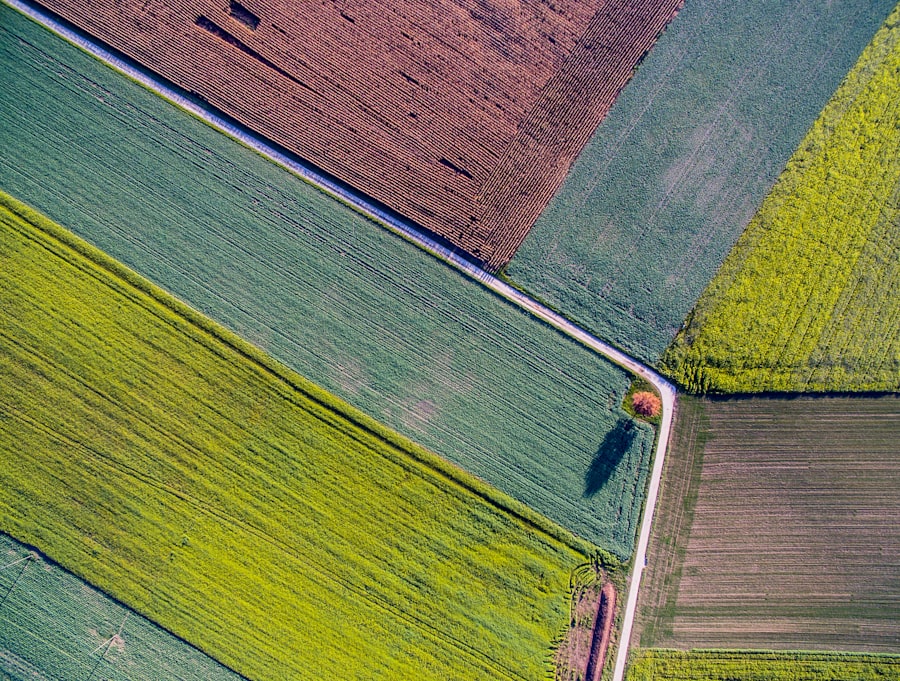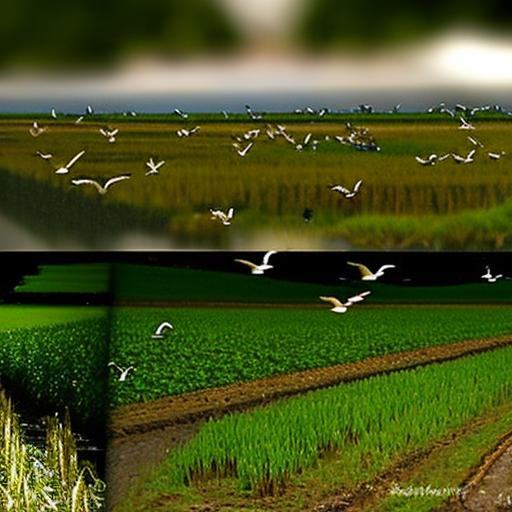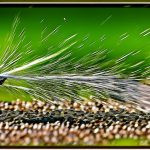The problem of geese damaging crops is a significant issue for farmers around the world. Geese are attracted to crop fields because they provide an abundant food source and a suitable habitat for nesting. However, their feeding and nesting habits can cause significant damage to crops, resulting in financial losses for farmers. It is important to find humane solutions to this problem, as geese are protected by law in many countries and killing or harming them is not an ethical or legal option.
Key Takeaways
- Geese are attracted to crop fields due to the abundance of food and open space.
- Physical barriers such as fences and netting can be effective in keeping geese away from crops.
- Decoys that mimic predators or other geese can deter geese from crop areas.
- Scare tactics such as loud noises or flashing lights can also be effective in keeping geese at bay.
- Repellents such as taste or scent deterrents can be used to keep geese out of crops.
Understanding the behavior of geese in crop fields
Geese are attracted to crop fields because they provide a rich food source. They feed on the grasses, grains, and other vegetation found in these areas. Additionally, crop fields often provide suitable nesting sites for geese, with tall grasses and vegetation providing cover and protection for their nests.
To effectively deter geese from crop fields, it is important to understand their feeding and nesting habits. Geese are most active during the early morning and late afternoon when they are searching for food. They tend to feed in groups and can quickly consume large quantities of crops. Geese also prefer open areas where they have a clear view of their surroundings, allowing them to spot potential predators.
Installing physical barriers to keep geese away
One effective method of keeping geese away from crop fields is by installing physical barriers. There are several types of physical barriers that can be used, including fences, netting, and scarecrows.
Fences can be an effective way to keep geese out of crop fields. They should be at least four feet high and made of a material that is difficult for geese to climb or fly over. Additionally, the bottom of the fence should be buried at least six inches into the ground to prevent geese from digging under it.
Netting can also be used to keep geese away from crops. It should be installed over the entire crop field, creating a barrier that prevents geese from accessing the crops. However, it is important to ensure that the netting is properly secured and does not pose a risk to other wildlife or farm animals.
Scarecrows can be an effective deterrent for geese. They should be placed strategically throughout the crop field, creating the illusion of a human presence. However, it is important to regularly move and change the scarecrows to prevent geese from becoming accustomed to them.
Using decoys to deter geese from crop areas
Another method of deterring geese from crop areas is by using decoys. Decoys are objects that resemble geese and can be used to create the illusion of a larger flock, which can deter geese from landing in the area.
There are several types of decoys that can be used, including stationary decoys and motion decoys. Stationary decoys are placed in the crop field and remain still, while motion decoys have moving parts that mimic the movement of real geese.
To properly use decoys for maximum effectiveness, it is important to place them strategically throughout the crop field. They should be spaced out and positioned in a way that creates a realistic flock pattern. Additionally, it is important to regularly move and rearrange the decoys to prevent geese from becoming accustomed to their presence.
Implementing scare tactics to keep geese at bay
Scare tactics can also be used to keep geese at bay. These tactics involve creating loud noises or sudden movements that startle and scare away geese.
There are several scare tactics that can be used, including noise makers, such as air horns or propane cannons, and visual deterrents, such as reflective tape or predator decoys. Noise makers should be placed strategically throughout the crop field and activated at regular intervals to create a sense of unpredictability. Visual deterrents should be placed in areas where geese are likely to land or feed, creating a visual deterrent that scares them away.
To properly use scare tactics for maximum effectiveness, it is important to vary the type and timing of the scare tactics used. This prevents geese from becoming accustomed to the scare tactics and increases their effectiveness in deterring geese from crop areas.
Using repellents to keep geese out of crops

Repellents can be another effective method of keeping geese out of crops. There are several types of repellents that can be used, including visual repellents, auditory repellents, and taste repellents.
Visual repellents include reflective tape or scare-eye balloons that create a visual deterrent for geese. Auditory repellents include devices that emit loud noises or predator calls that scare away geese. Taste repellents include chemicals or substances that make the crops unpalatable to geese.
Each type of repellent has its pros and cons. Visual repellents are easy to install and can be effective in deterring geese, but they may lose their effectiveness over time as geese become accustomed to them. Auditory repellents can be effective in scaring away geese, but they may also disturb other wildlife or farm animals. Taste repellents can be effective in making crops unpalatable to geese, but they may also affect the taste or quality of the crops.
Creating alternative feeding areas for geese
Creating alternative feeding areas for geese can be an effective method of keeping them away from crop fields. By providing an alternative food source, such as a designated feeding area with grasses or grains, geese are less likely to feed on crops.
To properly create alternative feeding areas, it is important to choose a location that is away from crop fields but still accessible to geese. The area should be large enough to accommodate a flock of geese and should provide a suitable food source. Additionally, it is important to regularly maintain and monitor the alternative feeding area to ensure that it remains attractive to geese.
Encouraging natural predators to control geese populations
Encouraging natural predators can be an effective method of controlling geese populations. Natural predators, such as coyotes or foxes, can help keep geese populations in check by preying on them or disrupting their nesting sites.
To encourage natural predators, it is important to create a suitable habitat for them. This can be done by providing areas of cover, such as tall grasses or shrubs, and by minimizing disturbances in their habitat. Additionally, it is important to avoid using pesticides or other chemicals that may harm or deter natural predators.
Timing crop planting and harvesting to avoid peak goose migration periods
Timing crop planting and harvesting to avoid peak goose migration periods can help reduce the risk of geese damaging crops. Geese are migratory birds and have specific periods when they are more likely to be present in certain areas.
To properly time crop planting and harvesting, it is important to research and understand the migration patterns of geese in the local area. This information can be obtained from local birdwatching groups or wildlife organizations. By planting crops before or after the peak migration periods, farmers can reduce the risk of geese damaging their crops.
Engaging in community efforts to manage geese populations
Engaging in community efforts to manage geese populations can be an effective way to address the problem of geese damaging crops. By working together with other farmers, landowners, and community members, farmers can share information and resources to develop effective strategies for managing geese populations.
Community efforts can include implementing coordinated scare tactics or physical barriers across multiple properties, creating alternative feeding areas on communal land, or organizing educational programs to raise awareness about the issue and promote humane solutions.
Seeking professional advice for effective and humane geese control methods
Seeking professional advice is important when it comes to finding effective and humane geese control methods. Professionals who specialize in wildlife management or bird control can provide valuable insights and recommendations based on their expertise and experience.
To find a professional who specializes in humane geese control methods, farmers can reach out to local wildlife organizations, agricultural extension offices, or pest control companies. It is important to choose a professional who has a proven track record of using humane methods and who understands the specific challenges and regulations related to geese control in the local area.
In conclusion, finding effective and humane solutions to the problem of geese damaging crops is crucial for farmers. Understanding the behavior of geese in crop fields, installing physical barriers, using decoys and scare tactics, implementing repellents, creating alternative feeding areas, encouraging natural predators, timing crop planting and harvesting, engaging in community efforts, and seeking professional advice are all viable options for managing geese populations in a humane way. By combining these methods and adapting them to the specific needs and challenges of their farm, farmers can protect their crops while respecting the welfare of geese.
If you’re looking for effective ways to protect your crops from geese, you might also be interested in learning how to convert a shed into a chicken coop. This article from Poultry Wizard provides valuable insights and step-by-step instructions on transforming a shed into a safe and comfortable home for your chickens. By creating a secure space for your feathered friends, you can not only enjoy fresh eggs but also deter geese from invading your crops. Check out the article here to discover the secrets of successful chicken coop conversion.
FAQs
What are the common crops that geese tend to damage?
Geese are known to damage crops such as wheat, barley, corn, soybeans, and other grains.
What are the methods to keep geese out of crops?
There are several methods to keep geese out of crops, including the use of scare tactics, physical barriers, repellents, and habitat modification.
What are some scare tactics that can be used to keep geese away from crops?
Scare tactics such as loud noises, visual deterrents like scarecrows or balloons, and predator decoys can be used to keep geese away from crops.
What are some physical barriers that can be used to keep geese out of crops?
Physical barriers such as fences, netting, and electric wires can be used to keep geese out of crops.
What are some repellents that can be used to keep geese away from crops?
Repellents such as taste repellents, odor repellents, and visual repellents can be used to keep geese away from crops.
What is habitat modification and how can it be used to keep geese out of crops?
Habitat modification involves altering the environment to make it less attractive to geese. This can include removing standing water, reducing grass height, and removing food sources.
Meet Walter, the feathered-friend fanatic of Florida! Nestled in the sunshine state, Walter struts through life with his feathered companions, clucking his way to happiness. With a coop that’s fancier than a five-star hotel, he’s the Don Juan of the chicken world. When he’s not teaching his hens to do the cha-cha, you’ll find him in a heated debate with his prized rooster, Sir Clucks-a-Lot. Walter’s poultry passion is no yolk; he’s the sunny-side-up guy you never knew you needed in your flock of friends!







